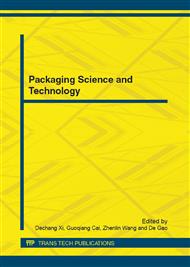p.98
p.104
p.109
p.114
p.118
p.122
p.126
p.131
p.136
Study on the Failure Mode of Corrugated Paperboard during Transport and Distribution
Abstract:
Corrugated paperboard is a kind of inexpensive and environmental-friendly packaging material and may be made into cushioning package pads to protect products from damaging during transport and distribution. By virtue of the static compression tests and impose four kinds of different compression speed on two kinds corrugated paperboard pads, This paper obtains the failure modes and the stress and strain curve. The results show that the failure of the corrugated board exhibit four stages, the linear elastic stage, the yield stage, plastic deformation and densification stage. The damage of corrugated structure pads occurs on yield and plastic deformation stage and structure damage mostly is shear crimpling on core layer. The damage of double layer corrugated paperboard is separated layer, first the bottom layer be damaged, then the top layer, until the corrugated paperboard is damaged wholly. In addition, we also find that the static compression speed has not significantly influence on the corrugated paperboard.
Info:
Periodical:
Pages:
118-121
Citation:
Online since:
October 2012
Authors:
Keywords:
Price:
Сopyright:
© 2012 Trans Tech Publications Ltd. All Rights Reserved
Share:
Citation:


